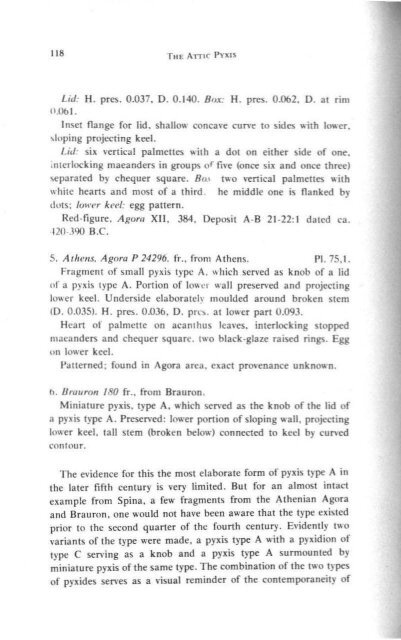You also want an ePaper? Increase the reach of your titles
YUMPU automatically turns print PDFs into web optimized ePapers that Google loves.
118<br />
THE ATTIC PYXIS<br />
SALLY RUTHERFt:RD ROBERn<br />
119<br />
Lid: H. pres. 0.037. 0.0.140. Box: H. pres. 0.062. D. at rim<br />
11.061.<br />
In~et flange for lid. shallo\\ concan~ cun"c 10 sides with 10'l1'cr.<br />
~l()ping projl."Cting keel.<br />
Ud' si~ \'crtical palmclles v.ilh a dot on either side of one,<br />
Interlocking maeanders in groups Of five (once six and once three)<br />
\eparated by chequer square. 80.' IWO \'ertical palmclles \\ith<br />
\\ hite hearts and most of a third he middle one is flanked by<br />
dots: /ul\'j" kl'd: egg pattern.<br />
ned-figure. Agortl XII, 384. Deposit A·B 21·22:1 dated ca.<br />
120-.190 R.e.<br />
S. A /lIf'11$, Agora P 24296. fr.. from Athens. PI. 75,1.<br />
Fragment (If small pyxis type A. which served as knob of a lid<br />
Ill" a pyxis type A. Portion of IOlh'1 wall preserved and projecting<br />
IOIH'r keel. Underside elaooralelv moulded around broken stem<br />
10.0.035), H. pres. 0.036, 0, ptl'l>, :I.t 10"'er part 0.093.<br />
Heart 01 palmetlc on acanlhus Iea\'t's, interlocking stopped<br />
lIl:lcanders and chequer square. two black-glaze raised rings. Egg<br />
un lower keel.<br />
!'atterned; found in Agora a~a. exact prO\'enance unknown.<br />
h. IJrollrOlI /80 fr .. from Brauron.<br />
MinialUre ppis. type A. whieh sen'ed as the knob of the lid of<br />
a pp-is type A. Presen'ed: low'er portion of sloping wall. projecting<br />
lower keel. tall stem (broken below) connected to keel by cuo'ed<br />
contour.<br />
The evidence for this the most elaborate form of pyxis type A III<br />
the later fifth century is very limited. But for an almost intact<br />
example from Spina. a few fragments from the Athenian Agora<br />
and Braurun. one would not have been aware that the lype existed<br />
prior 10 the second quarter of the fourth century. Evidently t.....o<br />
\'ariants of the type were made. a pyxis type A with a pyxidion of<br />
type C serving as a knob and a pyxis type A surmounted by<br />
miniature pyxis of the same type. The combination of the two types<br />
of pyxides sen'cs as a \'isual reminder of the contemporaneity of<br />
l~~ A and C and suggests that the potter "ho made one type.<br />
made lhe other. The c1assificatK>n of the doubk pyxis is based on<br />
that factor alone. The evidence at hand indicates that the mam lid<br />
was slightl} domed as in those of type C and the pyxidion<br />
supported on a li"tem swelling toward its apex. Judging by the<br />
number.> presened the t)PC became more popular in the first half<br />
of the fourth century.<br />
Ferrara. T. 27 C VP (no. I. PI. 73) has been preserved intact but<br />
for the lid of the p)'xidion of type e. The principal lid is slightly<br />
domed and the pyxis knob is joined to it by a slender stem which<br />
,,"ell.. at the junctiun, The walls of the box approach the cylindrical<br />
and the lower keel is pronounced in its extension. The flaring foot<br />
i!> tripllftite, The lid of the pyxidion was undoubtedly slightly<br />
domed with a lower rim as in the lids of those of standard size. For<br />
a miniature lid of type C see Athens. Agora P tJ097 (no. 2. PI.<br />
72.2) which is identical with the standard \'ersion exccpt that the<br />
smalll'entral clay medallion is not pierced to rccei\'e the u..ual ring<br />
handle. This miniature lid must have belonged either to such a<br />
pyxidton or to an independent miniature vase.<br />
The pyxis has been allributed to the Marlay Painter who also<br />
deroratt.'d pyxides of type C and an additional type A of another<br />
model.I' The vase dates to ca. 430 B.e. and thus prm'ides preeious<br />
c\idence for the production of such elaborate \'ases sixty years<br />
before the Kerch l>erK.~.1J A "fourth ccn!Ury' type b, thus shO\o\n 10<br />
han' its origin in the later fifth century.<br />
Athens. Agora P 12975 (no. 3. PI. 72.1). is a fragmentary<br />
pp,id ion uf type C from such a double vase. The hastily painted<br />
wreath is the usual decoration of such boxes of standard size. The<br />
date is difficult to determine and unfortunalely the vase does not<br />
come from a numbered deposil. u<br />
No, 4 (Pis. 74.2-74.3. 75.2) is a fragmentary example uf the<br />
~crond variety. a pyxis type A surmounted by a pyxidion of the<br />
same type. Of the box only the main lid is preserved whose com'ex<br />
central area. lower rim. 3nd broad two step stem-base as well a~ its<br />
modest diameter 01'0.014 show it to be from 3 ppis. type A. The<br />
!>tcm i~ broken just 3bo\'e the base. The pyxidion has slightly<br />
('onca\'e walls and a sloping lower keel from "hich the contour

















